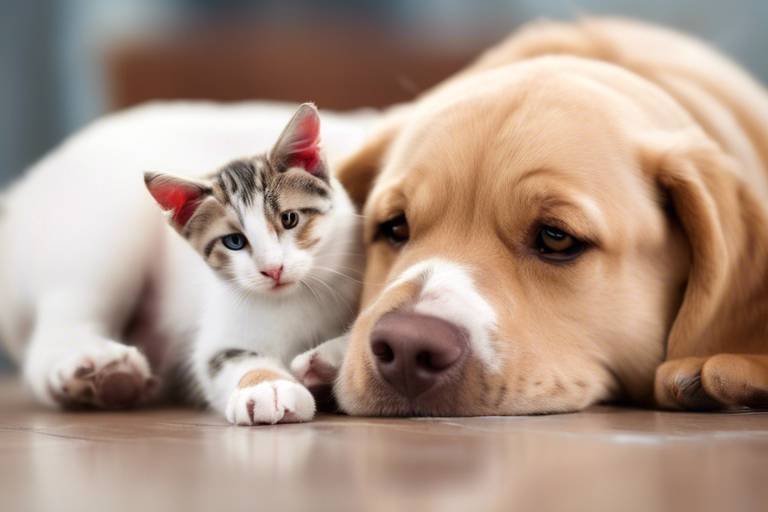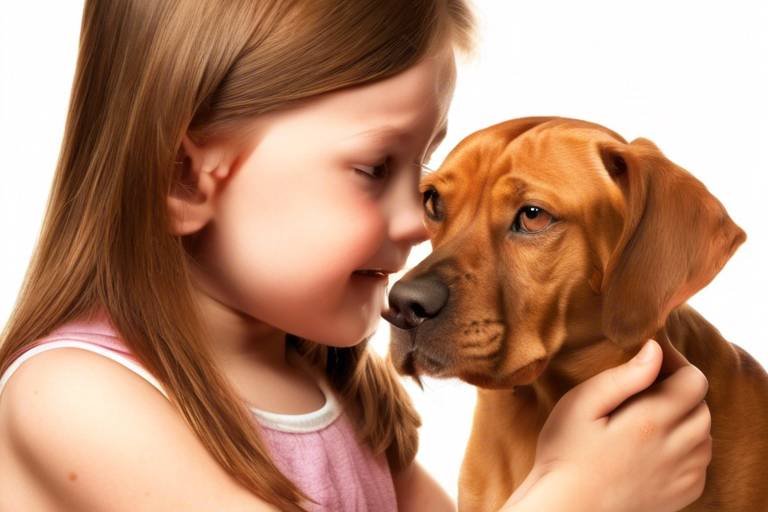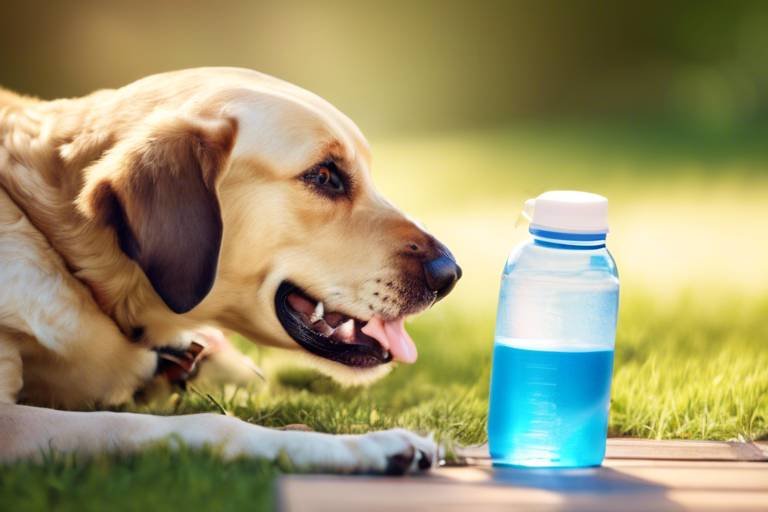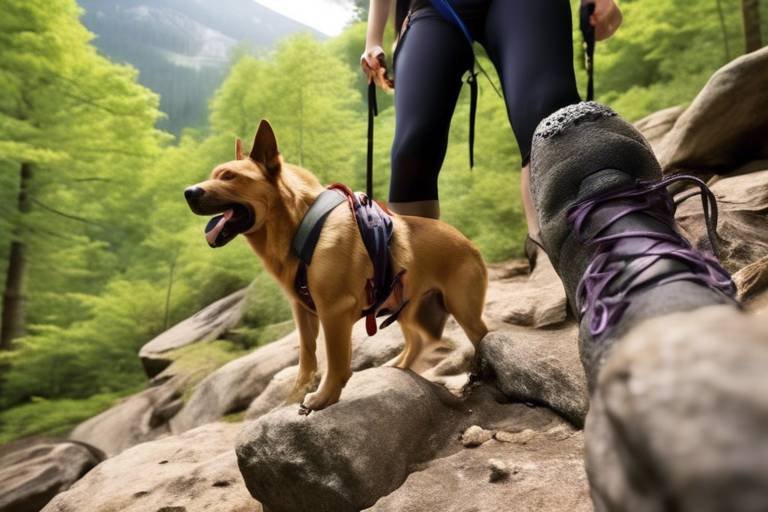How to Protect Your Pet from Seasonal Hazards
As pet owners, we often find ourselves worrying about our furry friends, especially when the seasons change. Each season brings its own set of challenges and hazards that can put our pets at risk. From the biting cold of winter to the blooming flowers of spring, and the sweltering heat of summer to the falling leaves of autumn, it’s essential to stay informed about the potential dangers lurking around us. But don’t fret! This article dives deep into the various seasonal hazards that pets face and offers effective strategies to keep them safe throughout the year, ensuring their health and well-being.
Different seasons bring unique challenges for pet owners. Understanding these hazards is crucial for taking proactive measures to protect your furry friends from potential dangers. For instance, winter can lead to frostbite and hypothermia, while spring introduces allergens and toxic plants. Summer heat can cause heatstroke, and autumn brings about risks associated with Halloween festivities and harvest foods. By being aware of these seasonal hazards, you can better prepare to keep your pets safe and healthy.
Cold weather can pose significant risks to pets. As temperatures drop, it is vital to ensure your pets are warm and comfortable. Here are some essential tips for keeping your pets safe during the winter months:
- Provide adequate shelter: Make sure your pets have a warm, dry place to stay, preferably indoors.
- Dress them up: Consider using pet sweaters or jackets to keep them warm during outdoor walks.
- Check their paws: Snow and ice can accumulate between their toes, leading to discomfort or injury.
Frostbite and hypothermia are serious conditions that can affect pets in extreme cold. Recognizing the signs and knowing how to respond can save your pet's life. Frostbite usually affects the ears, paws, and tail, and symptoms include pale or gray skin, swelling, and blisters. Hypothermia occurs when a pet's body temperature drops dangerously low, leading to shivering, lethargy, and even unconsciousness. If you notice any of these signs, it’s crucial to warm your pet gradually and seek veterinary care immediately.
Understanding the symptoms of frostbite is vital for early intervention. Look for:
- Cold, pale skin
- Swelling or blisters
- Blackened or dead skin
If you suspect frostbite, gently warm the affected areas with a warm (not hot) cloth and seek veterinary assistance as soon as possible.
Preventing hypothermia involves more than just keeping pets indoors. Here are practical measures to ensure your pet remains warm during outdoor activities:
- Limit outdoor time during extreme cold.
- Use pet-safe heating pads for extra warmth indoors.
- Keep their diet nutritious to help maintain body heat.
Pets may require dietary changes during winter months. Just like us, they burn more calories to stay warm in colder weather. Consider adding some extra protein or calories to their meals to support their energy needs. Always consult with your veterinarian before making significant changes to your pet's diet to ensure they’re receiving the right nutrition.
Spring brings its own set of risks, including allergies and toxins. As flowers bloom and pollen fills the air, many pets suffer from allergies. Common symptoms include sneezing, itching, and watery eyes. To help alleviate discomfort, try to manage your pet's exposure to allergens by keeping them indoors during peak pollen times and wiping their paws after walks.
Recognizing the symptoms of pollen allergies is crucial for managing your pet's comfort. If you notice your pet scratching excessively or having trouble breathing, it might be time for a trip to the vet. They can recommend antihistamines or other treatments to help relieve your pet's discomfort.
Spring is a time for blooming flowers, but some can be toxic to pets. Common toxic plants include:
- Lilies
- Daffodils
- Azaleas
When gardening, opt for pet-safe plants to create a beautiful yet safe environment for your furry friends.
Summer heat can be dangerous for pets. As temperatures soar, it’s essential to take precautions to prevent heatstroke and dehydration. Always ensure your pets have access to fresh water and a cool place to rest. Avoid taking them out during peak heat hours, usually between 10 a.m. and 4 p.m.
Recognizing the symptoms of heatstroke is crucial for timely intervention. Signs include excessive panting, drooling, lethargy, and vomiting. If you notice these symptoms, move your pet to a cooler area immediately, offer water, and cool them down gradually with wet towels. If symptoms persist, seek veterinary care.
Engaging in outdoor activities during summer is enjoyable but requires caution. Always carry water for your pet during walks, and consider investing in a pet cooling vest for those particularly hot days. Plan activities for early mornings or late evenings when temperatures are cooler to ensure your pet stays comfortable and safe.
As leaves fall and temperatures drop, autumn presents its own hazards. One major concern is Halloween, where costumes can pose risks. If you choose to dress your pet up, ensure the costume fits well and does not restrict movement or breathing.
When selecting a costume for your pet, prioritize comfort and safety. Avoid any accessories that could be choking hazards and ensure that your pet can see and hear properly while wearing it.
With harvest season comes potential dangers, including toxic foods. Foods like grapes, raisins, and certain nuts can be harmful to pets. During festivities, ensure your pet doesn’t have access to these foods to keep them safe.
Q: How can I tell if my pet is too cold?
A: Signs that your pet may be too cold include shivering, whining, or seeking shelter. If your pet seems uncomfortable, it’s best to bring them indoors.
Q: What should I do if my pet eats something toxic?
A: If you suspect your pet has ingested something toxic, contact your veterinarian or an emergency animal poison control hotline immediately for guidance.
Q: How can I prevent my pet from overheating in the summer?
A: Ensure your pet has access to plenty of water, avoid walks during the hottest parts of the day, and provide shade when outside.
By staying informed and taking proactive steps, you can protect your beloved pets from seasonal hazards and ensure they lead happy, healthy lives throughout the year.

Understanding Seasonal Hazards
When it comes to our beloved pets, understanding the seasonal hazards they face is crucial for ensuring their safety and well-being. Each season brings its own unique set of challenges that can pose risks to our furry friends. From the cold, biting winds of winter to the blooming flowers of spring, and the scorching heat of summer to the crisp leaves of autumn, each change in the season can impact your pet's health in various ways. As responsible pet owners, it is our duty to stay informed and proactive about these potential dangers.
For instance, in winter, pets are at risk of frostbite and hypothermia, both of which can be life-threatening if not addressed promptly. During the spring, the increase in pollen can lead to allergies, while certain plants that bloom this time of year can be toxic to pets. Summer brings the danger of heatstroke, especially for breeds that are more susceptible to heat. As the leaves fall in autumn, we must also be wary of Halloween costumes and the potential for pets to ingest harmful foods during harvest festivities.
To effectively protect our pets, it’s essential to recognize the signs of distress related to these hazards. For example, knowing how to identify heatstroke symptoms or recognizing the signs of an allergic reaction can make a world of difference. Additionally, being aware of common toxic plants, such as oleander and lilies, can help you create a safe environment for your pets during the spring.
Ultimately, understanding seasonal hazards is not just about recognizing the risks; it’s about taking action. This can mean providing appropriate shelter during the winter months, adjusting your pet's diet with the change of seasons, or simply keeping a watchful eye on them during outdoor activities. By being informed and prepared, we can ensure that our pets enjoy each season safely and happily.

Winter Safety Tips
As the winter chill sets in, it’s essential to keep our furry companions warm and safe. Cold weather can be harsh, and pets are not always equipped to handle it like we are. Just like we bundle up in cozy sweaters and thick jackets, our pets need protection too! Here are some crucial tips to ensure your pet remains comfortable and healthy during the winter months.
First and foremost, proper shelter is vital. If your pet spends time outdoors, make sure they have access to a warm, dry place that is insulated from the cold. A well-constructed doghouse with straw bedding can keep them snug. However, if the temperatures drop significantly, it’s best to bring your pets indoors. Remember, they are part of the family and deserve to be warm and safe!
Another critical aspect is clothing. Not all pets require jackets, but for smaller breeds or those with short fur, a well-fitted coat can make a world of difference. Look for materials that are both warm and waterproof. Just like you wouldn’t want to go out in the snow without proper attire, your pet shouldn’t either! If you’re unsure whether your pet needs a coat, observe their behavior; if they seem to shiver or hesitate to go outside, it might be time to invest in some winter gear.
While we’re talking about keeping them warm, let’s not forget about paw care. Ice and snow can be tough on your pet’s paws. Consider using paw wax or dog booties to protect their feet from cold surfaces and harmful chemicals like salt used to melt ice. After walks, check their paws for cracks or ice build-up, as these can cause discomfort. Just like we check our shoes for snow, we need to do the same for our pets!
It's also important to monitor their diet during winter. Pets often require more calories in colder weather to maintain their energy levels. You might want to consult with your veterinarian about increasing their food intake or switching to a higher-calorie diet. Think of it like preparing for a winter hike; you wouldn’t want to venture out without enough fuel!
Lastly, be mindful of frostbite and hypothermia. These are serious conditions that can affect pets in extreme cold. If your pet shows signs of distress, like excessive shivering, lethargy, or difficulty walking, it’s crucial to act immediately. Wrap them in warm blankets and contact your veterinarian. Being aware of these symptoms can literally save your pet's life.
In summary, winter can be a beautiful season, but it also poses unique challenges for pet owners. By providing proper shelter, clothing, and nutrition, along with careful monitoring of their health, you can ensure that your furry friends enjoy the winter wonderland safely and happily.
Q: How can I tell if my pet is too cold?
A: Look for signs such as shivering, whining, or seeking shelter. If they seem reluctant to go outside or are lifting their paws off the ground, it’s time to bring them indoors.
Q: Is it safe to leave my pet outside in winter?
A: It depends on the breed and the temperature. Generally, if it’s too cold for you, it’s too cold for them. Always provide a warm shelter and consider bringing them inside during extreme weather.
Q: Can I use human clothing for my pet?
A: While some human clothing can work, it’s best to use clothing specifically designed for pets to ensure a proper fit and comfort.
Frostbite and Hypothermia
As the winter chill sets in, it's essential to be aware of the dangers that cold weather poses to our beloved pets. Frostbite and hypothermia are two serious conditions that can affect pets exposed to extreme cold. Understanding these risks is the first step in protecting your furry friends. Imagine being outside in frigid temperatures without proper clothing—your pets feel the same way! They rely on us to keep them safe and warm.
Frostbite occurs when the skin and underlying tissues freeze, usually affecting the extremities such as paws, ears, and tails. It can lead to permanent damage if not treated promptly. On the other hand, hypothermia is a life-threatening condition that occurs when a pet's body temperature drops too low, affecting their ability to function normally. Both conditions can escalate quickly, so recognizing the signs is crucial.
So, what should you look for? Here are some common symptoms of frostbite:
- Discoloration of the skin (pale or bluish hue)
- Cold or hard areas on the body
- Swelling and blisters
- Pain or sensitivity when touched
For hypothermia, watch out for:
- Shivering or shaking
- Weakness or lethargy
- Slow or shallow breathing
- Stumbling or difficulty walking
Recognizing these signs early can make all the difference. If you suspect your pet is suffering from frostbite, it's vital to seek veterinary care immediately. Meanwhile, you can take some initial steps to help your pet. Gently warm the affected areas with your hands, but avoid using hot water or heating pads, as this can cause further damage. Wrap your pet in warm blankets and keep them calm until you can get to the vet.
Preventing hypothermia is just as important. Ensure your pet has a warm, dry place to retreat to when they are outside. If you must take them out for a walk, limit their time in the cold and consider using pet-friendly sweaters or coats. Just like we bundle up in winter gear, our pets need their own protection against the elements!
In summary, being vigilant about the signs of frostbite and hypothermia can save your pet's life. Regular checks after outdoor time and providing adequate shelter are essential steps to ensure your furry friends stay safe and warm during the winter months.
Q: How can I tell if my pet is too cold?
A: Look for signs like shivering, reluctance to walk, or seeking warmth. If your pet seems uncomfortable, it's time to head indoors!
Q: Are certain breeds more susceptible to frostbite?
A: Yes, smaller breeds and those with short hair are more vulnerable to cold weather than larger, thicker-coated breeds.
Q: What should I do if my pet gets frostbite?
A: Seek veterinary care immediately. In the meantime, gently warm the affected areas and keep your pet calm.
Signs of Frostbite
When the temperatures plummet, our furry friends can face serious risks, and frostbite is one of the most critical conditions to watch out for. Just like humans, pets can suffer from frostbite, which occurs when their skin and underlying tissues freeze due to extreme cold. It’s essential to be vigilant and recognize the signs early to prevent long-term damage or even loss of limbs. So, what should you be looking for?
First and foremost, affected areas may exhibit a change in color. Healthy skin is typically a nice pink hue, but frostbite can turn the skin pale, bluish, or even black. This color change indicates that the tissue is not receiving adequate blood flow and is at risk of dying. If you notice these colors on your pet's ears, paws, or tail, it's a serious red flag!
Temperature is another critical factor. If your pet's skin feels unusually cold to the touch, especially in the extremities, it could be a sign of frostbite. You might also notice that your pet is shivering or acting restless, as they may be uncomfortable due to the cold. In some cases, they might even whimper or cry, which can be heartbreaking to witness. These behavioral cues are your pet's way of expressing their discomfort and alerting you to the danger they are in.
Moreover, if your pet is showing signs of swelling or blisters in the affected areas, it’s time to take immediate action. Blisters may form as the skin begins to thaw, and it’s crucial to prevent your pet from licking or biting at these areas, as this can lead to infection. If you notice any of these symptoms, you should consult your veterinarian as soon as possible. They can provide the necessary treatment and advice on how to care for your pet's frostbitten areas.
In summary, here are the key signs of frostbite to keep an eye out for:
- Color change: Pale, bluish, or black skin.
- Cold skin: Extremities feel unusually cold to the touch.
- Shivering or restlessness: Signs of discomfort due to the cold.
- Swelling or blisters: These may indicate damage to the skin.
Being proactive and observant can make all the difference for your pet during those chilly months. If you suspect frostbite, don’t hesitate to reach out to your vet. Remember, your pet relies on you to keep them safe and warm!
Q: How can I prevent frostbite in my pet?
A: To prevent frostbite, limit your pet's exposure to extreme cold, provide warm shelter, and consider using pet clothing such as jackets or booties when taking them outside in freezing temperatures.
Q: What should I do if I think my pet has frostbite?
A: If you suspect frostbite, gently warm the affected area with lukewarm water or a warm cloth. Avoid using hot water or heating pads. Contact your veterinarian immediately for further advice and treatment.
Q: Can frostbite cause permanent damage to my pet?
A: Yes, severe frostbite can lead to permanent damage, including tissue death and loss of limbs. Early detection and treatment are crucial to minimize long-term effects.
Preventing Hypothermia
When winter rolls in, the chill can creep up on us and, unfortunately, our pets are not immune to the cold. Hypothermia is a serious condition that occurs when a pet's body temperature drops below the normal range, putting their health at risk. So, how can you ensure your furry friend stays warm and safe during those frosty months? Let’s dive into some practical strategies that will keep your pet snug as a bug!
First and foremost, it’s essential to understand that not all pets are created equal when it comes to cold tolerance. For example, short-haired breeds or elderly pets may struggle more in colder temperatures than their fluffy counterparts. To prevent hypothermia, consider the following:
- Limit Outdoor Time: Keep outdoor excursions brief during extremely cold days. A quick potty break is fine, but prolonged exposure can be dangerous.
- Provide Adequate Shelter: If your pet spends time outside, make sure they have a warm, insulated shelter that protects them from wind and moisture. A dry, draft-free space is crucial.
- Dress Your Pet: Depending on the breed, a cozy sweater or coat can make a world of difference. Look for pet apparel that covers their belly and neck, as these areas are particularly vulnerable to the cold.
- Warm Bedding: Create a warm resting area with blankets or heated pet beds that provide comfort and warmth, especially for older pets or those with health issues.
Additionally, it’s important to monitor your pet closely for signs of hypothermia. If you notice them shivering, acting lethargic, or seeking warmth, it’s time to bring them indoors and warm them up. Remember, prevention is always better than cure!
Another key factor in preventing hypothermia is nutrition. A well-balanced diet can help your pet maintain their body temperature. During colder months, consider adjusting their food intake to ensure they have enough energy to stay warm. Consult your veterinarian for tailored advice on dietary changes that suit your pet’s specific needs.
Lastly, be aware of the signs of hypothermia. If your pet exhibits any of the following symptoms, seek veterinary assistance immediately:
- Shivering
- Weakness
- Stiffness
- Slow heart rate
- Unresponsiveness
Understanding these signs can be the difference between life and death for your beloved pet. By taking proactive measures, you can ensure that your furry friend enjoys the winter months without the risk of hypothermia. Remember, keeping your pet warm is not just about comfort; it’s about their overall health and well-being!
1. How can I tell if my pet is too cold?
Watch for signs such as shivering, whining, or seeking shelter. If they seem uncomfortable, it's time to bring them inside.
2. Are certain breeds more susceptible to cold?
Yes, short-haired and small breeds, as well as elderly or sick pets, are generally more sensitive to cold temperatures.
3. Can I use human blankets for my pet?
Absolutely! Just ensure they are safe and free from any choking hazards. A cozy human blanket can provide warmth and comfort.
4. Is it safe to leave my pet outside during winter?
If you must leave your pet outside, ensure they have a proper shelter and limit their time outdoors, especially during extreme cold spells.
Winter Diet Adjustments
As the chill of winter sets in, it’s not just the weather that changes; your pet’s dietary needs may also require a thoughtful adjustment. Just like humans, pets need extra energy to maintain their body heat during the colder months. This means that the food you provide can play a crucial role in their overall health and comfort. So, what should you consider when it comes to adjusting your pet's diet for winter?
First and foremost, it's essential to increase their caloric intake. Pets tend to burn more calories in the winter as their bodies work harder to stay warm. This is especially true for outdoor pets or those who love to romp in the snow. You might want to look into high-quality, energy-dense foods that can help them stay warm and energized. Look for foods that are rich in protein and fat, as these nutrients can provide the necessary fuel during the cold months.
Another important factor is hydration. While it might seem that hydration is less of a concern in winter, pets can still become dehydrated, especially if they are eating dry kibble. Make sure your pet has access to fresh water at all times. You might even consider adding some wet food to their diet, which can provide both hydration and additional nutrients.
Additionally, if your pet has specific dietary needs or health conditions, consult with your veterinarian to tailor their diet appropriately. For instance, older pets or those with joint issues may benefit from diets that include supplements for joint health, particularly in winter when cold weather can exacerbate these issues.
Here’s a quick breakdown of what to focus on in your pet’s winter diet:
- Increase caloric intake: Opt for energy-dense foods.
- Hydration: Ensure fresh water is always available, consider wet food.
- Consult your vet: Tailor the diet based on your pet's specific needs.
In conclusion, adjusting your pet's diet during winter is not just a good idea; it’s essential for their health and happiness. By paying attention to their nutritional needs, you can help them thrive even in the coldest months. Remember, a well-fed pet is a happy pet!
Q: How can I tell if my pet is getting enough calories in winter?
A: Monitor your pet's weight and energy levels. If they seem lethargic or are losing weight, consider increasing their food intake.
Q: Should I change my pet's food for winter?
A: You may want to switch to a higher-calorie food during winter months, especially if your pet spends a lot of time outside.
Q: How can I keep my pet hydrated in winter?
A: Ensure they have access to fresh water at all times and consider incorporating wet food into their diet to help with hydration.

Spring Hazards
As the chill of winter fades away and the vibrant colors of spring emerge, our furry companions often find themselves at the mercy of new hazards. While we relish the blooming flowers and sunny days, it's essential to remember that spring brings along its own set of challenges for pets. From pesky pollen that can trigger allergies to the potential dangers lurking in our gardens, being aware of these hazards is crucial for ensuring the safety and well-being of our beloved pets. So, how can we navigate this season while keeping our pets safe? Let’s dive into some common spring hazards and explore effective strategies to protect our four-legged friends.
One of the most prevalent issues during spring is the increase in pollen allergies. Just like humans, many pets can suffer from seasonal allergies, which can lead to discomfort and health issues. Symptoms often include excessive itching, sneezing, and watery eyes. If you notice your pet exhibiting these signs, it could be a reaction to the pollen floating in the air. To help alleviate their discomfort, try to limit their outdoor exposure during peak pollen times, typically in the morning. Additionally, regular grooming can help remove pollen from your pet's coat, reducing the chances of them ingesting it while grooming themselves.
Another spring hazard that pet owners should be aware of is the presence of toxic plants. As gardens bloom, some plants can be harmful or even deadly to pets. For instance, lilies, azaleas, and tulips are known to be toxic to dogs and cats. If you're planning to spruce up your garden, consider opting for pet-safe alternatives such as marigolds or sunflowers. It's also wise to educate yourself on the plants that are common in your area and their potential effects on pets. Keeping your garden secure and monitoring your pet's outdoor activities can significantly reduce the risk of accidental ingestion.
To further emphasize the importance of awareness, let’s take a look at a table that highlights some common toxic plants and their symptoms:
| Plant Name | Toxicity Symptoms |
|---|---|
| Lilies | Vomiting, lethargy, loss of appetite |
| Azaleas | Drooling, vomiting, diarrhea |
| Tulips | Vomiting, diarrhea, depression |
| Foxglove | Heart issues, vomiting, diarrhea |
Being proactive is key! Regularly inspecting your yard for any potentially dangerous plants can prevent unfortunate incidents. If you suspect your pet has ingested something harmful, don’t hesitate to contact your veterinarian immediately. Remember, knowledge is power when it comes to keeping our furry friends safe!
As we embrace the beauty of spring, let’s not forget that a little vigilance goes a long way. By understanding the common hazards that come with the season, we can ensure our pets enjoy the fresh air and blooming landscapes without unnecessary risks. After all, a happy pet makes for a happy home!
Q: What should I do if my pet shows signs of allergies?
A: If your pet exhibits symptoms like itching or sneezing, consult your veterinarian for advice. They may recommend antihistamines or other treatments to relieve your pet's discomfort.
Q: How can I create a pet-safe garden?
A: Research and choose non-toxic plants for your garden. Regularly inspect your yard for harmful plants, and ensure your pet doesn’t have access to areas with toxic flora.
Q: Are there any home remedies for pet allergies?
A: Some pet owners find relief using regular baths to wash off allergens from their pets' coats. However, always check with your vet before trying new remedies.
Pollen Allergies
As the flowers bloom and the trees regain their lush green, many of us welcome the beauty of spring with open arms. However, for our furry friends, this season can be a double-edged sword. Just like humans, pets can suffer from , which can lead to discomfort and health issues. It's essential to recognize the signs of these allergies and take proactive steps to minimize their impact on your pet's well-being.
So, what exactly happens when your pet encounters pollen? When pets inhale or come into contact with pollen, their immune system may overreact, leading to a variety of symptoms. Common signs of pollen allergies include:
- Itchy skin: This is often the first indicator. Your pet may scratch, bite, or lick at their skin, leading to redness and irritation.
- Runny eyes and nose: Just like us, pets can experience watery eyes and nasal discharge.
- Sneezing and coughing: These respiratory symptoms can also be a clear sign of allergies.
If you notice these symptoms in your pet, it's crucial to consult your veterinarian for a proper diagnosis and treatment plan. They may recommend antihistamines or even allergy testing to pinpoint specific allergens.
To help manage your pet's pollen allergies during the spring months, consider implementing the following strategies:
- Limit outdoor exposure: Try to keep your pet indoors during peak pollen times, typically early morning or on windy days.
- Regular baths: Giving your pet a bath after outdoor activities can help wash off any pollen that may have clung to their fur.
- Clean your home: Frequent vacuuming and using air purifiers can help reduce indoor pollen levels.
Additionally, if you enjoy gardening, be mindful of the plants you choose. Opt for low-pollen varieties to create a pet-friendly garden. Some pet-safe plants include:
| Plant Name | Benefits |
|---|---|
| Lavender | Calming scent; safe for pets |
| Spider Plant | Air purifier; non-toxic |
| Boston Fern | Natural humidifier; safe for pets |
By being proactive and attentive, you can help your pet enjoy the beauty of spring without the discomfort of pollen allergies. Remember, a little extra care goes a long way in ensuring your furry friend stays happy and healthy during this vibrant season.
Q: What are the common symptoms of pollen allergies in pets?
A: Common symptoms include itchy skin, runny eyes and nose, sneezing, and coughing. If you notice these signs, consult your veterinarian.
Q: How can I reduce my pet's exposure to pollen?
A: Limit outdoor activities during peak pollen times, bathe your pet after being outside, and keep your home clean with regular vacuuming and air purifiers.
Q: Are there specific plants I should avoid in my garden?
A: Yes, avoid high-pollen plants such as ragweed and certain types of grasses. Instead, opt for low-pollen varieties that are safe for pets.
Toxic Plants
As spring unfolds and gardens burst into vibrant life, it's essential to recognize that not all plants are safe for our furry companions. While you might be tempted to let your pets explore the blooming beauty around them, some plants can be downright dangerous. Imagine your pet frolicking in the garden, only to encounter a toxic flower that could lead to serious health issues. This is why understanding which plants are harmful is crucial for every pet owner.
Common toxic plants include:
- Foxglove: This beautiful plant can cause severe heart problems if ingested.
- Lilies: Particularly dangerous for cats, lilies can lead to kidney failure.
- Aloe Vera: While great for humans, aloe can cause vomiting and diarrhea in pets.
- Oleander: Even small amounts can be fatal, affecting the heart and causing severe gastrointestinal distress.
It's not just about knowing the names of these plants; it's about creating a safe environment for your pets. If you have a garden, consider replacing toxic plants with pet-friendly alternatives. For instance, instead of foxglove, try planting marigolds or sunflowers, which are safe and bright. Additionally, if you're unsure about a plant, it's always a good idea to consult with your veterinarian or do a quick online search before introducing any new greenery to your home.
As a precaution, keep a close eye on your pets when they are outside, especially in gardens or parks where unfamiliar plants may be present. If you suspect your pet has ingested a toxic plant, don’t wait—contact your veterinarian immediately. The sooner you act, the better the chances of a full recovery. Remember, prevention is always better than cure, and keeping your pet safe from toxic plants is a significant step in ensuring their health and happiness.
Q: How can I identify toxic plants in my garden?
A: Research is key! Use online databases or consult your veterinarian to learn about toxic plants in your area. You can also find plant identification apps that can help you determine which plants are safe for your pets.
Q: What should I do if my pet eats a toxic plant?
A: If you suspect your pet has ingested a toxic plant, contact your veterinarian immediately. They will provide guidance on the necessary steps to take, which may include bringing your pet in for treatment.
Q: Are there any plants I can safely have around my pets?
A: Yes! Some pet-friendly plants include spider plants, Boston ferns, and certain types of herbs like basil and rosemary. Always double-check before introducing new plants to your home.

Summer Precautions
As the temperature rises and the sun shines brighter, summer can be a delightful time for both pets and their owners. However, it also brings a set of challenges that require our attention. Just like we need to stay hydrated and cool, our furry friends do too! It's essential to take precautions to ensure their safety and well-being during these hot months. One of the most significant risks is heatstroke, which can happen surprisingly quickly. Have you ever noticed how dogs pant heavily after a short walk? That's their way of cooling down, but if they can't regulate their temperature, it can lead to serious health issues.
So, how can we keep our pets safe in the summer heat? First, always ensure they have access to fresh water. Hydration is crucial, especially during outdoor activities. You might think of carrying a portable water bowl with you on walks or hikes. Additionally, try to plan your outings during the cooler parts of the day, such as early morning or late evening. If you’re heading out for a fun day at the park, consider bringing along some shade, like an umbrella or a portable pet tent, where your pet can take a break from the sun.
It's also vital to be aware of the signs of heatstroke. Symptoms can include excessive panting, drooling, weakness, and in severe cases, loss of consciousness. If you notice any of these signs, it’s important to act quickly. Move your pet to a shaded area, offer them water, and apply cool (not cold) water to their body to help lower their temperature. If their condition doesn’t improve, don’t hesitate to contact your veterinarian.
Another aspect of summer safety is ensuring that your pets have a safe environment for outdoor play. While it’s tempting to let them roam freely, there are hidden dangers, such as hot pavement or sharp objects. Did you know that pavement can reach scorching temperatures that burn their paws? To test if it’s safe, place your hand on the ground for seven seconds; if it’s too hot for you, it’s too hot for them! On particularly hot days, consider taking them to a dog-friendly beach or a lake, where they can cool off and have a blast splashing around.
Moreover, be cautious of summer activities that might seem fun but can pose risks. For example, fireworks can be terrifying for pets, leading to anxiety or even escape attempts. If you plan to celebrate with fireworks, keep your pets indoors in a safe and quiet space. Similarly, be cautious with barbecues; many foods that humans enjoy can be toxic to pets, such as grapes, onions, and chocolate. Always keep an eye on what they’re munching on during outdoor gatherings.
| Heatstroke Symptoms | What to Do |
|---|---|
| Excessive panting | Move to a shaded area and offer cool water |
| Drooling | Apply cool water to their body |
| Weakness | Contact your veterinarian if no improvement |
| Loss of consciousness | Seek immediate veterinary care |
In conclusion, while summer can be a joyous time filled with sunshine and outdoor adventures, it’s vital to remain vigilant about your pet’s safety. By taking simple precautions, you can ensure that your furry companions enjoy the summer just as much as you do. Remember, a little extra care goes a long way in keeping your pets happy and healthy!
- What are the signs of heatstroke in pets? Look for excessive panting, drooling, weakness, and loss of consciousness.
- How can I keep my pet hydrated during summer? Always provide fresh water and consider using a portable water bowl during outings.
- Is it safe to walk my dog on hot pavement? Test the pavement with your hand; if it's too hot for you, it's too hot for them.
- What foods should I avoid giving my pet during summer barbecues? Be cautious of grapes, onions, chocolate, and any foods that are toxic to pets.
Heatstroke Symptoms
When the summer sun blazes down, our furry friends can be at serious risk of heatstroke. It's crucial for pet owners to recognize the signs early, as heatstroke can escalate quickly and lead to severe health issues or even death. So, what should you be on the lookout for? First and foremost, observe your pet's behavior closely. If they seem excessively panting or are drooling more than usual, it's a red flag. Panting is a natural cooling mechanism for dogs, but when it becomes rapid and labored, it's a sign that your pet is struggling to regulate their body temperature.
Another symptom to watch for is lethargy. If your pet is usually lively and suddenly becomes unresponsive or sluggish, it could indicate overheating. Additionally, you may notice their gums turning bright red or even pale, which is a sign of distress. If their breathing becomes shallow or they start to vomit, it's time to act quickly. Other symptoms include:
- Confusion or disorientation
- Excessive drooling
- Unsteady walking or stumbling
- Seizures
In extreme cases, your pet may collapse, which is a critical emergency. If you suspect your pet is experiencing heatstroke, it’s vital to cool them down immediately. Move them to a shaded or air-conditioned area, apply cool (not cold) water to their body, and offer them small amounts of water to drink. Always consult a veterinarian as soon as possible, even if your pet seems to recover. Remember, prevention is the best medicine—keep your pets hydrated and avoid strenuous activities during the hottest parts of the day!
Q: What should I do if I think my pet has heatstroke?
A: Move your pet to a cooler area immediately, apply cool water, and contact your veterinarian right away.
Q: How can I prevent heatstroke in my pet?
A: Ensure your pet has access to fresh water, avoid exercise during peak heat, and provide shade when outdoors.
Q: Are certain breeds more susceptible to heatstroke?
A: Yes, brachycephalic breeds (like Bulldogs and Pugs) and older pets are particularly vulnerable to heat-related issues.
Safe Outdoor Activities
Summer is the perfect time for outdoor adventures with your furry friend, but it’s crucial to prioritize their safety while enjoying the sunshine. Just like we wouldn’t want to run a marathon in the scorching heat without proper hydration, our pets need the same level of care. Engaging in outdoor activities can be a blast, but we must be vigilant about the risks that come with the heat. So, how do we ensure our pets have a fun yet safe summer?
First and foremost, always keep an eye on the temperature. Ideally, you want to plan your outdoor activities during the cooler parts of the day, such as early morning or late evening. This not only reduces the risk of overheating but also makes for a more pleasant experience for both you and your pet. If you’re heading out for a hike or a long walk, carry plenty of water for both of you. Hydration is key! You can even bring along a portable pet water bottle to make it easier for your dog to stay hydrated on the go.
When engaging in outdoor play, be mindful of the surfaces your pet is walking on. Hot pavement or sand can burn their paws, leading to painful injuries. A good rule of thumb is to place the back of your hand on the ground for seven seconds; if it’s too hot for your hand, it’s too hot for their paws! Consider investing in dog booties if you frequently walk on hot surfaces. These can provide an extra layer of protection and comfort.
For those who love a good game of fetch, consider using toys that are specifically designed for summer play. Look for floatable toys if you’re near water, or durable chew toys that can withstand the excitement of outdoor play. Just remember to supervise your pet during playtime, as they can easily overexert themselves. If your pet shows signs of fatigue or distress, take a break and find some shade to cool off.
Additionally, it’s important to be aware of local wildlife and potential hazards. While your pet may be curious about a squirrel or a rabbit, not all encounters are safe. Keep your pet on a leash to avoid unwanted confrontations and to ensure they don’t wander off into dangerous territory. If you’re exploring areas with tall grass or dense brush, be cautious of ticks and other pests. Regularly check your pet for ticks after outdoor activities, especially in wooded or grassy areas.
In summary, summer outdoor activities can be a joyous time for you and your pet, but they come with responsibilities. By planning your outings wisely, keeping an eye on the temperature, ensuring your pet stays hydrated, and being aware of potential hazards, you can create a safe and enjoyable environment for your furry companion. So grab that leash, pack some water, and get ready to make some unforgettable summer memories!
- What are the signs of overheating in pets?
Look for excessive panting, drooling, weakness, or disorientation. If you notice these symptoms, move your pet to a cooler area immediately. - Can I take my pet swimming?
Yes, but make sure they are comfortable in water and always supervise them. Not all pets are natural swimmers, so consider using a life vest. - How often should I hydrate my pet during outdoor activities?
Offer water every 15-20 minutes during activities, especially in hot weather, to keep them well-hydrated. - Are there any specific toys recommended for summer play?
Look for durable, floatable toys that can withstand rough play and are easy for your pet to carry.

Autumn Awareness
As the vibrant colors of fall foliage blanket the ground and the air turns crisp, it’s easy to get caught up in the beauty of the season. However, autumn brings its own set of hazards that pet owners need to be aware of to keep their furry friends safe. From Halloween festivities to the dangers of certain foods, being informed and prepared can make all the difference in ensuring your pet enjoys the season as much as you do.
One of the most exciting parts of autumn is Halloween, but it’s essential to consider how this festive time can impact your pet. Costumes, decorations, and trick-or-treating can all pose potential risks. For example, while dressing up your pet might seem like a fun idea, many costumes can be uncomfortable or even hazardous. Make sure that any costume you choose doesn’t restrict movement, vision, or breathing. It's also crucial to avoid any accessories that could be chewed off and swallowed, leading to choking hazards or digestive issues.
Moreover, the excitement of visitors on Halloween night can be overwhelming for pets. The constant ringing of doorbells and the influx of strangers can cause anxiety in even the calmest of animals. To mitigate this, consider creating a safe space for your pet away from the commotion, complete with their favorite toys and a cozy blanket. This way, they can feel secure while you enjoy the festivities.
Another autumnal concern is the abundance of harvest foods that can be toxic to pets. While it’s tempting to share your delicious pumpkin pie or apple cider donuts, many human foods can be harmful to our furry companions. Foods like chocolate, grapes, and certain nuts are well-known for their toxicity. Additionally, the seeds and stems of pumpkins can also pose a risk if ingested. It's important to be vigilant about what your pet has access to during gatherings and festivities. Always keep an eye on your plate and ensure that your guests know not to feed your pet anything that could be harmful.
Here’s a quick overview of some common autumn foods to avoid:
| Food | Risk |
|---|---|
| Chocolate | Can cause vomiting, diarrhea, and even seizures. |
| Grapes and Raisins | Can lead to kidney failure. |
| Onions and Garlic | Can damage red blood cells, leading to anemia. |
| Macadamia Nuts | Can cause weakness, tremors, and hyperthermia. |
As the leaves fall and the weather cools, it’s also a good idea to keep an eye on your pet's outdoor activities. With the changing environment, pets may encounter new hazards like mushrooms or other fungi that can be toxic if ingested. Always supervise your pets during outdoor excursions and teach them to avoid unknown plants. If you suspect your pet has ingested something harmful, reaching out to your veterinarian immediately is crucial.
In summary, while autumn is a season of beauty and fun, it’s essential to remain vigilant about the potential hazards that can affect our pets. By taking proactive measures, such as choosing safe costumes, monitoring what your pet eats, and supervising outdoor activities, you can ensure that your furry friends enjoy the season just as much as you do.
- What should I do if my pet eats something toxic during autumn? If you suspect your pet has ingested something harmful, contact your veterinarian or an emergency animal clinic immediately for guidance.
- How can I help my pet adjust to the Halloween festivities? Create a quiet space for your pet away from the noise and excitement, and consider using calming aids if they are particularly anxious.
- Are there any safe treats I can give my pet during autumn celebrations? Yes! Consider offering small pieces of cooked pumpkin or apple slices (without seeds) as a safe treat.
Pet Costume Safety
As Halloween approaches, many pet owners are excited to dress up their furry friends in adorable costumes. However, while it’s tempting to let your pet join in on the fun, costume safety should be a top priority. Just like humans, pets can face various risks when wearing costumes, and it’s essential to ensure that their outfits are not only cute but also safe and comfortable.
When selecting a costume for your pet, consider the following factors to avoid any mishaps:
- Size Matters: Ensure the costume fits your pet properly. A costume that is too tight can restrict movement and cause discomfort, while one that is too loose may pose a tripping hazard.
- Material Safety: Check the fabric of the costume. Avoid materials that could irritate your pet’s skin or that are easily torn. Breathable fabrics are ideal, especially if your pet is likely to wear the costume for an extended period.
- No Small Parts: Steer clear of costumes with small accessories or embellishments that could be chewed off and swallowed, leading to choking hazards or digestive issues.
- Comfort First: Your pet should be able to move freely, see clearly, and breathe comfortably. Avoid costumes that cover their eyes, ears, or nose, as this can lead to anxiety and discomfort.
It’s also essential to monitor your pet while they’re in costume. Some pets may feel stressed or anxious in unfamiliar attire, and it’s crucial to recognize the signs of discomfort. If your pet seems agitated, it’s best to remove the costume and allow them to relax. Remember, the goal is to have fun, not to stress your furry companion!
Lastly, consider alternatives to traditional costumes. If your pet isn’t a fan of dressing up, you might opt for festive accessories like a themed bandana or a simple collar decoration. This way, your pet can still participate in the celebration without the potential drawbacks of a full costume.
In summary, ensuring your pet's safety while dressing them up for Halloween or any festive occasion is vital. By choosing the right size, material, and design, you can help your pet enjoy the fun while keeping them safe and comfortable. Always prioritize their well-being over aesthetics, and you’ll both have a wonderful time celebrating together!
Here are some common questions pet owners may have regarding costume safety for their pets:
- Can all pets wear costumes? Not all pets enjoy wearing costumes. If your pet shows signs of distress, it’s best to skip the costume altogether.
- How can I tell if my pet is uncomfortable in their costume? Look for signs such as excessive panting, trying to remove the costume, or hiding. If you notice any of these behaviors, it’s time to take the costume off.
- Are there specific materials I should avoid? Yes, avoid costumes made from materials that could irritate your pet’s skin, such as rough fabrics or those with strong dyes.
- What are some safe alternatives to costumes? Consider festive collars, bandanas, or themed toys that allow your pet to join in the celebration without the discomfort of a full costume.
Harvest Hazards
As the leaves begin to change and the air turns crisp, autumn brings with it a sense of coziness and celebration. However, it also introduces some serious hazards for our beloved pets. One of the most significant risks during this season is the potential for toxic foods that often accompany harvest festivals, Halloween, and Thanksgiving. While we indulge in seasonal treats, it’s vital to remember that certain foods can be harmful or even fatal to our furry friends.
For instance, many pet owners may not realize that common autumn foods like grapes, raisins, and chocolate can be extremely toxic to dogs and cats. Even small quantities can lead to severe health issues, including kidney failure or gastrointestinal distress. It’s essential to keep these foods well out of reach, especially during gatherings when food is abundant and guests may inadvertently feed their snacks to your pet.
Additionally, the fall season is synonymous with pumpkin, which is often celebrated in various dishes. While pure pumpkin is safe and even beneficial for pets in moderation, beware of pumpkin products that contain added spices, sugars, or other ingredients that can be harmful. Always opt for plain, canned pumpkin if you want to share this seasonal delight with your pet.
Another critical aspect to consider during harvest time is the potential for decorative items to pose risks. Pumpkins and gourds, while festive, can lead to gastrointestinal blockages if ingested. Ensure that any decorations are placed high enough to prevent curious paws from reaching them. Moreover, the use of candles and other decorations can be hazardous, especially if your pet is prone to knocking things over.
It's also worth noting that autumn brings about an increase in outdoor activities, such as hayrides and corn mazes. While these can be enjoyable outings for the whole family, be cautious of pesticides and herbicides that may be used on farms. These chemicals can be harmful if ingested or absorbed through the skin. Always check with the venue about their safety practices before bringing your pet along for the fun.
To summarize, keeping your pet safe during the harvest season requires vigilance and awareness. Here’s a quick reference to some common hazards:
| Hazard | Potential Risks | Safety Tips |
|---|---|---|
| Toxic Foods | Kidney failure, gastrointestinal distress | Keep foods like grapes, raisins, and chocolate out of reach |
| Decorative Items | Blockages, injuries | Place decorations out of reach; avoid candles |
| Pesticides | Poisoning, skin irritation | Check with venues about chemical use |
By staying informed and taking the necessary precautions, you can ensure that your pet enjoys the beauty and festivities of autumn without falling victim to the hazards that lurk during this vibrant season. Your furry friend deserves to be safe and happy while you celebrate the joys of harvest time!
Q: What should I do if my pet ingests a toxic food?
A: If you suspect your pet has eaten something toxic, contact your veterinarian or an emergency animal poison control hotline immediately. Quick action can save your pet's life.
Q: Are all pumpkins safe for pets?
A: Plain, cooked pumpkin is safe and beneficial for pets in moderation. However, avoid products with added sugars or spices.
Q: How can I keep my pet safe during outdoor fall activities?
A: Always supervise your pet, avoid areas that may have been treated with chemicals, and ensure they are leashed in crowded places to prevent accidents.
Frequently Asked Questions
- What are the common seasonal hazards for pets?
Seasonal hazards for pets can vary, but they often include extreme temperatures, toxic plants, and allergens. For instance, winter can bring frostbite and hypothermia, while spring may introduce pollen allergies and toxic blooms. Each season has its unique challenges that every pet owner should be aware of.
- How can I keep my pet warm during the winter?
To keep your pet warm during the winter, ensure they have a cozy shelter, limit outdoor time in extreme cold, and consider using pet-friendly clothing like sweaters or coats. Additionally, providing extra bedding and ensuring they have access to fresh, unfrozen water can help maintain their body temperature.
- What are the signs of frostbite in pets?
Signs of frostbite in pets include pale or grayish skin, swelling, and blisters on the affected areas. If you notice your pet shivering excessively or showing signs of pain, it’s crucial to seek veterinary assistance immediately to prevent further damage.
- How do I know if my pet has hypothermia?
Hypothermia in pets can be indicated by symptoms such as shivering, lethargy, weakness, and a decreased heart rate. If you suspect hypothermia, try to warm your pet gradually and contact your veterinarian for guidance.
- What dietary changes should I make for my pet in winter?
During winter, pets may require more calories to maintain their energy levels. Consider adjusting their diet by adding more protein or fat, and ensure they have access to fresh water at all times. Always consult your vet before making significant changes to their diet.
- How can I protect my pet from spring allergies?
To protect your pet from spring allergies, limit their outdoor exposure during high pollen days, wipe their paws after walks, and consider using air purifiers indoors. If symptoms persist, consult your veterinarian for potential allergy treatments.
- Which plants are toxic to pets in spring?
Common toxic plants include lilies, azaleas, and tulips. It's essential to research any new plants you plan to introduce into your garden and opt for pet-safe alternatives to keep your furry friends out of harm’s way.
- What are the signs of heatstroke in pets?
Signs of heatstroke in pets include excessive panting, drooling, vomiting, and lethargy. If you notice these symptoms, it's vital to cool your pet down immediately and seek veterinary care.
- How can I keep my pet cool during summer activities?
Keep your pet cool during summer by providing plenty of fresh water, scheduling walks during cooler parts of the day, and ensuring they have access to shaded areas. You can also bring along cooling mats or vests for extra comfort during outdoor activities.
- What should I consider for pet costumes during Halloween?
When choosing a costume for your pet, ensure it fits properly without restricting movement or vision. Avoid any small parts that can be chewed off and ingested. Always monitor your pet while they're in costume to ensure they’re comfortable and safe.
- What foods should I avoid giving my pet during harvest season?
During harvest season, avoid giving your pet foods like grapes, raisins, and certain nuts, as these can be toxic. Stick to pet-safe treats and ensure any festive foods are out of reach to keep your furry friends safe.



















